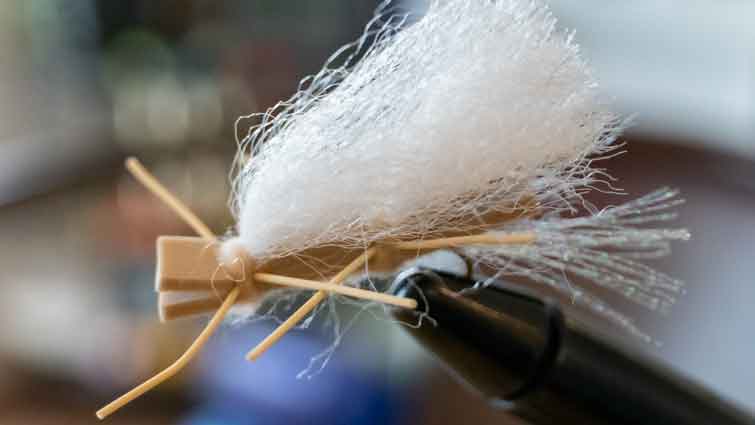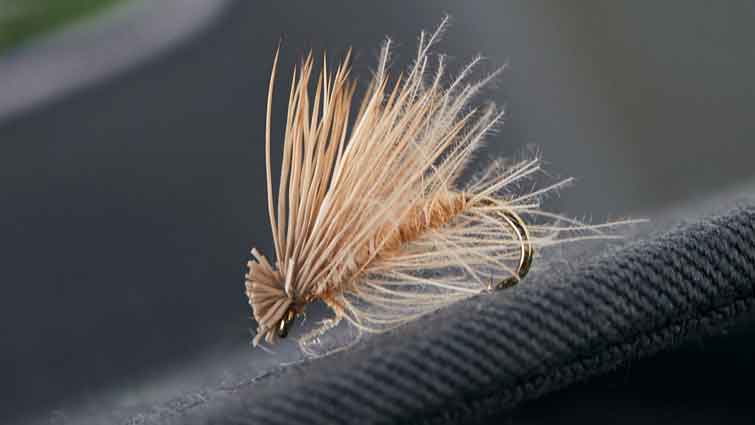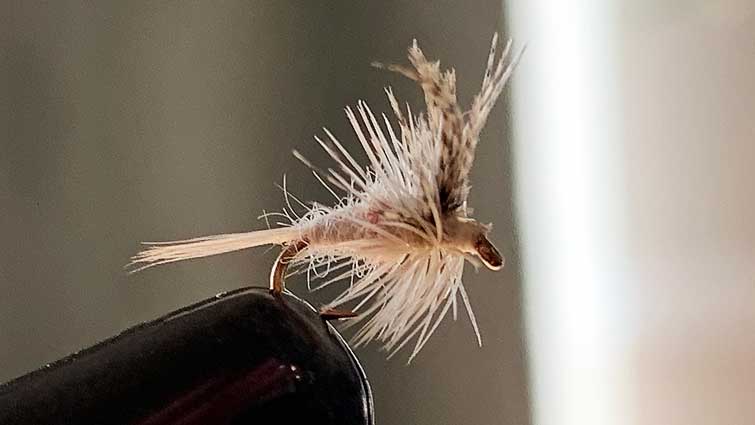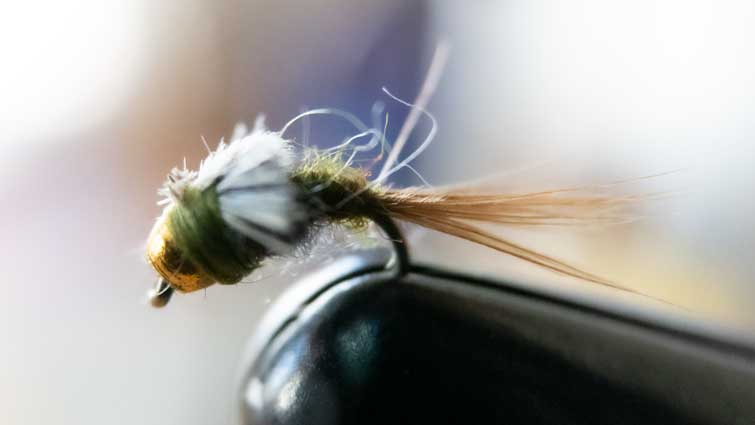Brown trout are some of the most popular game fish in North America. They can be found in lakes, streams, and rivers throughout the United States and Canada. Their popularity is mainly due to their size and willingness to take your best fly fishing fly.
The best flies for brown trout include Dry flies size 12-16, wet flies size 12-16, nymphs size 12-22, streamers 4-6, ideally. You may get by with others at times, but you should have a range of sizes and colors in your box to handle all possibilities.

Brown trout vary significantly in coloration depending on where they live, but they are usually dark brown to light green with very distinct spots covering their entire body (except for parts of their mouth). Many anglers like to use flies that imitate local baitfish or insects that these brown trout prey upon. In this article we’ll look at some of the best flies to use for catching brown trout.
Which Flies To Use For Brown Trout?
If you're looking for large trout, then look no further than the Brown Trout. Some of the largest trout in the world can be found in our freshwater systems, with brown trout being one of them. They're considered sea-run fish, and it's often that they grow up to or larger than eight or nine pounds.
When it comes to what size and color of fly to use, there is no hard and fast rule when it comes to brown trout, so it is recommend using flies with multiple shades on them so you can replicate all the different stages of life in their prey, and sizes between 12-16 will cover most bases.

Some of the best flies to use for brown trout include
- Pheasant Tail Nymph – Size 12.
- Crayfish – Size 8 and 10.
- Green Caddis with and without a bead head – Size 14.
- Bead Head Hare's Ear Nymph – Size 14.
When fishing for brown trout in lakes, try getting your fly as deep as possible by using larger-sized flies with weighted droppers. Streamers are an excellent choice for this situation.

If you're fishing a river, then Terrestrials or Stoneflies imitations will work great. Stoneflies and terrestrial insects land on rivers and lakes around dusk, so this may be an excellent time to try them out. Another excellent choice would be Muddler Minnows.
When is the Best time to catch Brown Trout?
Aquatic insects live for about eleven months beneath the water surface. Brown trout will consume larva, nymphs, and pupae at any time of year. These forms are frequent and easy to catch fish on.
In general feeding time is the best time to catch trout. Target when midges and other bugs are at their most active. Late evenings and early mornings on warmer days are also good times. In colder times of the year, the warmest part of the day will be your best time.

It makes it easier for fishermen to select and pack flies depending on the season and location they wish to fish. To determine which patterns to use with the hatch, understand the life cycles of these insects.
Brown Trout Fly Fishing in the US.
Brown and other trout sometimes feed on forage at the bottom, but they aren’t common bottom feeders. Late spring is the optimum time to catch trout, especially if you're seeking bigger fish. As the temperature rises, so does fishing pressure from other anglers, the vegetation and brush surrounding their habitats grow thicker, and water levels fall.

Brown trout are often dark brown to golden yellow along the back, with a brassy sheen. The yellowish sides are marked with black to black spots, which are bordered by pale blue haloed in bright blue. Whitish is the usual color of the belly. The hooked jaw is occasionally seen on breeding males.
Brown trout spawn are fall spawners, starting in late October, sometimes extending into December. Adult brown trout feed on insects and their larvae, crustaceans, mollusks, amphibians, small rodents, and other fish. Brown trout are frequently active in the daytime as long as they are unharmed. The activity level of larger fish generally increases at night.
Nymph Patterns for Catching Brown Trout
When fly fishing for brown trout, using nymph patterns can be extremely effective. Nymphs resemble aquatic insects and fish regard them as a great food source. Trout are opportunistic feeders, which means that they will only move to eat a fly if it makes sense for them to do so.

1. Zebra Midge
The Zebra Midge is a nymph that disguises itself as midge pupae and/or budding midges. The Zebra is simply made up of a size 16-24 shrimp/scud hook wrapped in colored thread with a 2 or 3mm tungsten bead head of matching metallic finish.
2. JuJu Bee Midge
The JuJu Bee Midge or JuJu Beatis is a popular fly pattern to mimic blue-winged olive nymphs. The resemblance between the real thing and the JuJu Baetis is almost perfect. Because the Colorado river systems' Baetis nymphs can range in size from 16 to 22, keep a selection of sizes on hand.

3. Copper John
The Copper John Nymph imitates mayflies and stoneflies. Trout are fans of these tiny insects, and they can be found in the Spring, Summer, Fall, especially during the hatch.
The Copper John Nymph can be used in slow, fast and highly-flowing rivers, where trout love to stay hidden on the bottom. It is great for nymphing not only because it imitates a mayfly's size and life cycle, but also because it is made of copper.
This shiny metal attracts fish with its brightness and reflects light under water. Its silver coloration makes this fly easily go unnoticed by trout even though they might be very close to it.

4. Rainbow Warrior
The Rainbow Warrior's nymph-like shape may imitate a midge or mayfly nymph as it emerges, but it is generally just a bright bug that attracts the interest of the trout we want to catch.
Rainbow Warriors are tied with a white chenille body, peacock sword fibers for the tail and wings, and a natural brown hackle. A Rainbow warrior fly pattern should be used anytime rocks, or other hazards create fast riffles that trout can use as ambush points. The main purpose of this fly is to imitate emerging midge pupa.

Dry Flies for Catching Brown Trout
Dry Flies work during mayfly hatches, caddis hatches, and in smaller sizes, midge hatches. This imitates the stage trout prefer—an emerging mayfly with the shuck still sticking to its back end.
5. Elk Hair Caddis
The Elk Hair Caddis is a searching pattern because it mimics the form of adult caddisflies or tiny stoneflies. The Elk Hair Caddis has been tied in a range of wing, hackle, and body colors to resemble various caddis and small stoneflies since its inception.
The Elk Hair Caddis is a western fly pattern developed to imitate the Green Caddis. It is a useful caddisfly imitation for fishing with streamers as the naturals fall from tree overhangs.

6. Parachute Adams
The Parachute Adams is available in several different variations and sizes. If you have only one version of the Adams in your tackle box for trout fishing, the optimum design is the Parachute Adams.
The Parachute Adams is a dry fly that can capture trout on the surface of rivers and streams throughout North America, including those that aren't considered to be hotspots for trout fishing. This is because the Parachute Adams resembles various insect species, making it one of the most adaptable flies in any trout fisherman's arsenal.
This fly is versatile and can be used in various ways to catch trout, particularly the Parachute Adams because its bright colors make it easy to see in fly fishing. It comes in different colors, but try this one out if you're looking for something bigger than nymphs. This fly imitates many insects like stoneflies or midges, which are two kinds of insect that hatch very often.

Streamer Patterns for Catching Brown Trout
Fly fishing with streamers is a fantastic way to quickly cover a large area of water. Streamer fishing draws out bigger fish that are ready to eat large flies. Casting flies, these streamer patterns are successful for trout, bass, pike, musky, salmon, steelhead, and panfish anglers.
Brown trout seem to like it, and the streamer has shown to be an effective pattern for catching them. These are flies with tufts of feathers on them that cause movement in the water and entice trout to strike whatever is moving toward them. It's a fantastic approach since you can cover a lot of water in not too much time.

7. Muddler Minnow
The Muddler Minnow is a baitfish imitation streamer pattern with deer hair as the major component. Deer hair is extremely buoyant, creating a spatial "muddler" action in the water, which is an excellent fish attractor. Other species of fish that are attracted to this pattern are trout, bass, pike, salmon, steelhead, and panfish.
The muddler minnow is an excellent fly for targeting browns in both the spring and fall seasons. The muddler minnow streamer is perfect for targeting big fish, who are more inclined to strike what appears larger to them.

8. Zonker
A zonker is a fly made from a strip of fur. The strips are known as zonker strips, and they have the hide attached. Once waterlogged, this softens and creates a fly with bulk that pulsates when retrieved.
For bigger flies, it's ideal, such as streamers and pike fly patterns. It's a type of strip streamer that is longer and narrower than a typical bucktail streamer. It may be fished either as a still water fly or an emerger pattern, bringing them to the surface from below.
This is a versatile sort of fly, and it's possible to utilize it in many ways. However, having this kind of fly come in the fly boxes allows you to mix up your flies as necessary. This type of fly is effective at imitating a variety of bugs and insects that trout eat throughout the year.

9. Muddy Buddy
The Muddy Buddy pattern is famous for its mobility and adaptability. The Muddy Buddy is not only a deadly trout fly but it may also be fished as a bass fly in warmer climates. It's an old favorite method of taking trophies to the net. The muddy buddy olive fly is an excellent combination of the Muddler and Zonker that works well for Trout, Stillwater fishing, and Steelhead.
The Muddy Buddy is a deadly fly for trout in all seasons. Anything that can capture bass, pike, salmon, steelhead, and panfish may also catch brown trout. The Muddy Buddy resembles many insects, such as stoneflies or midges; it's the ideal type of fly to use while targeting several species of fish.
What Colors Do Brown Trout Like?
The best answer to this is to match the hatch, trout will feed on whatever is hatching. The trout's eye is also more sensitive to the red wavelength than a human's. Green is the color it has the least capacity to detect, while blue is the color it can see best.
What Kind of Flies Do Brown Trout Eat?
The average brown trout eats insects and other invertebrates such as shrimp, caddisflies, stoneflies, and mayflies. Both larvae and adults are consumed by the fish, which will eat whatever insect life is available at the moment.
Artificial flies resembling these insects can be used to catch brown trout. Mature brown trout are attracted to ants, hoppers, beetles, and other attractor patterns at this time.
Brown trout are not picky eaters - they will nibble on whatever insect comes their way. It doesn't matter what time of the season it is or where the water is coming from; if there are flies around, then you'll be able to catch some brown trout! All these flies work well for catching browns because they imitate the bugs that land often on rivers and streams, and when fish eat them, they can't help but bite.
There are many trout flies that work well for brown trout, depending on location and time of year. However, there are a few go-to patterns that you will want to have ready for every trip! Your ideal fly choices for trout are Zebra Midge, JuJu Baetis, Copper John Nymphs, Rainbows Warrior, Elk Hair Caddis Parachute Adams, and more.

About the Author
Matthew Bernhardt, a third-generation Coloradan, grew up at the forefront of the state’s fly-fishing revolution, enjoying time on the water side by side with experienced guides and lifelong anglers.
By combining his passion for fly-fishing with input from other experienced fly-fishers and guides and his fine arts degree from Colorado State University, Matthew spent five years carefully developing the Drifthook Fly Fishing System, built to help every angler catch more trout.
When he’s not spending time with his wonderful family, you’ll find him out on the water catching MONSTER trout, and he anxiously looks forward to the day when his kids are old enough to join him there.







